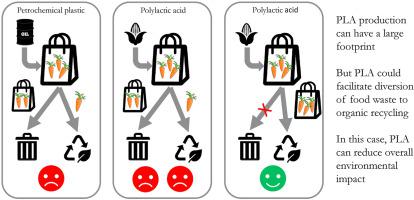Journal of Cleaner Production ( IF 11.1 ) Pub Date : 2021-07-18 , DOI: 10.1016/j.jclepro.2021.128377 George Bishop 1 , David Styles 2 , Piet N.L. Lens 1

|
Polylactic acid (PLA) is a compostable bio-based plastic that can be used for food packaging, potentially increasing separation of (packaged) food waste for targeted, more circular organic waste management via anaerobic digestion, industrial composting, or (in the future) insect protein meal feed production. Consequential life cycle assessment (LCA) was undertaken to rigorously assess the environmental impact of displacing petrochemical plastic packaging of fresh fruit and vegetables with PLA. Eight end-of-life scenarios of bioplastic packaging were evaluated against a business-as-usual petrochemical packaging scenario, expanding LCA boundaries to include end-of-life impacts of fruit and vegetable food waste within a UK context. PLA production has a higher impact compared with petrochemical plastic production across many impact categories, but diversion of PLA-packaged food waste to organic recycling can compensate for this, improving the overall environmental performance of bioplastic packaging scenarios. Future diversion of organic waste streams to insect feed (following regulatory change) would lead to the best environmental outcomes, followed by anaerobic digestion. Impact categories ameliorated in bioplastic scenarios include human health effects, climate change, freshwater eutrophication, ionising radiation, photochemical ozone formation, resource use energy carriers, and respiratory inorganics. On the other hand, petrochemical plastic scenarios generate smaller burdens for acidification, marine and terrestrial eutrophication, ozone depletion, and water scarcity. Sensitivity analyses indicate high improvement potential for bioplastic scenarios if the energy efficiency of PLA production can be increased, or if globalised production shifts to industrialised countries with cleaner energy mixes (that currently import most of their plastics). Whilst end-of-life management of the fruit and vegetable food waste has a considerable influence on environmental outcomes, plastic packaging represents a surprisingly large share of the dry matter material flow (about 25%) in fresh produce waste streams. Therefore, it is imperative that future LCA studies of food packaging account for both packaging and (diverted) food waste end-of-life flows.
中文翻译:

生鲜食品生物塑料包装的环境性能:相应的生命周期评估
聚乳酸 (PLA) 是一种可堆肥的生物基塑料,可用于食品包装,有可能通过厌氧消化、工业堆肥或(未来)增加(包装的)食品垃圾的分离,以进行有针对性的、更循环的有机垃圾管理昆虫蛋白粉饲料生产。进行后续生命周期评估 (LCA) 以严格评估用 PLA 取代新鲜水果和蔬菜的石化塑料包装对环境的影响。生物塑料包装的八种报废方案根据常规石化包装方案进行评估,扩大 LCA 边界以包括英国环境中水果和蔬菜食品废物报废的影响。与石化塑料生产相比,PLA 生产在许多影响类别中具有更高的影响,但将 PLA 包装的食物垃圾转用于有机回收可以弥补这一点,提高生物塑料包装方案的整体环境性能。未来将有机废物流转用于昆虫饲料(随着监管变化)将带来最佳的环境结果,其次是厌氧消化。生物塑料情景中改善的影响类别包括人类健康影响、气候变化、淡水富营养化、电离辐射、光化学臭氧形成、资源利用能源载体和呼吸无机物。另一方面,石化塑料情景对酸化、海洋和陆地富营养化、臭氧消耗和水资源短缺产生的负担较小。敏感性分析表明,如果 PLA 生产的能源效率可以提高,或者如果全球化生产转向具有更清洁能源组合的工业化国家(目前进口大部分塑料),生物塑料方案的改进潜力很大。虽然水果和蔬菜食物垃圾的报废管理对环境结果有相当大的影响,但塑料包装在新鲜农产品废物流中占干物质流的惊人份额(约 25%)。因此,未来对食品包装的 LCA 研究必须同时考虑包装和(转移的)食品废物报废流。虽然水果和蔬菜食物垃圾的报废管理对环境结果有相当大的影响,但塑料包装在新鲜农产品废物流中占干物质流的惊人份额(约 25%)。因此,未来对食品包装的 LCA 研究必须同时考虑包装和(转移的)食品废物报废流。虽然水果和蔬菜食物垃圾的报废管理对环境结果有相当大的影响,但塑料包装在新鲜农产品废物流中占干物质流的惊人份额(约 25%)。因此,未来对食品包装的 LCA 研究必须同时考虑包装和(转移的)食品废物报废流。



























 京公网安备 11010802027423号
京公网安备 11010802027423号